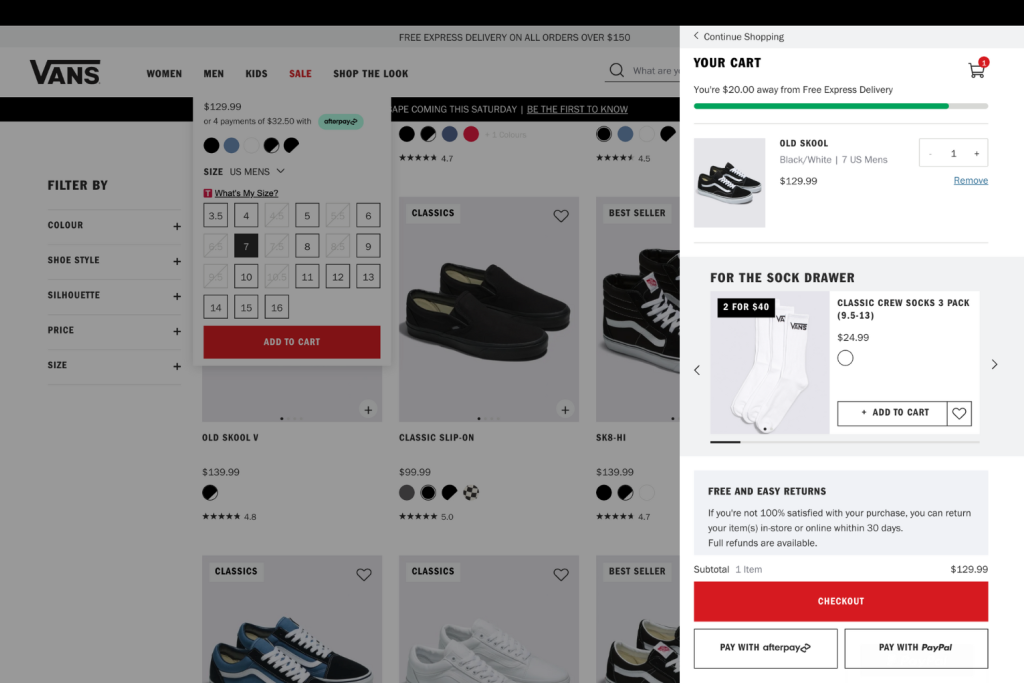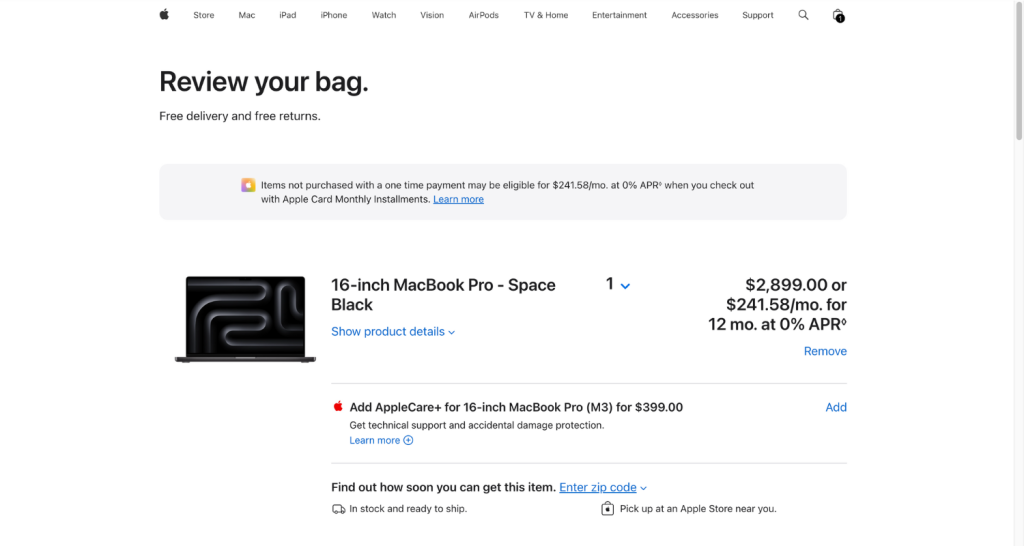
You probably hear the terms upsell and cross-sell often thrown together when it comes to ecommerce businesses. These two sales strategies help maximize revenue for your ecommerce success.
While they both help in increasing revenue, they both serve different purposes, with their own pros and cons. This is why it’s critical to know when to use each tactic. Understanding the nuances of cross-selling and upselling helps you tailor your strategy better, leading to more effective and efficient marketing campaigns.
Ready to boost your sales and enhance the shopping experience? Let’s dive into how these techniques can transform your business.
Understanding cross-selling and upselling
Cross-selling and upselling are powerful strategies to boost revenue and improve the customer experience in ecommerce. Let’s explore what these terms mean and why they are essential for your business.
Cross-Selling: This marketing strategy involves recommending related products that complement your customers’ initial purchase. For example, if a potential buyer buys a camera, you might suggest purchasing a memory card or camera bag.
The main goal of cross-selling is to add overall value to the customer’s purchase. When I say ‘value,’ I don’t mean its actual monetary value. Instead, it means meeting the additional needs they may not have considered initially.
Examples of Cross-Selling
- Tech: Buying a laptop and being offered a mouse, laptop bag, gadget insurance, or antivirus software.
- Fashion: Purchasing a dress and recommending matching accessories or shoes to complete the outfit.
- Grocery Stores: Buying a box of pasta and suggesting a complimentary pasta sauce or salad dressing.
- Beauty: Buying a skincare product and recommending a matching cleanser or serum.
- Automotive: Purchasing a car and being offered floor mats, a GPS system, or an extended warranty.
- Books: Buying a novel and suggesting the sequel or a related genre book.
- Fitness: Purchasing a yoga mat and recommending a water bottle or resistance bands.

These cross-selling techniques enhance the shopping experience, making it more convenient and satisfying for customers.
Upselling: This strategy is a bit similar to cross-selling, where it involves a stronger way of recommending to customers. In this strategy, you want to encourage your buyers to purchase a more expensive version of the product they’re initially interested in. It can also mean encouraging them to add more premium features together with the product they’re buying.
Let’s take the camera example earlier. Instead of recommending additional items to purchase, you instead encourage the customer to buy a higher version of the camera. The goal of upselling is to encourage a ‘better’ product for the customers to buy.
Examples of Upselling
- Service Industry: When booking a hotel room, customers might be offered an upgraded suite with additional amenities or a premium view.
- Electronics: When purchasing a smartphone, suggesting a model with more storage, a better camera, or additional accessories like a wireless charger.
- Automotive: When buying a car, offering a higher trim level with more features, an extended warranty, or advanced safety packages.

These examples of upselling demonstrate how providing more valuable options can lead to higher customer satisfaction and increased sales.
Both strategies are critical for your online business because they aim to maximize your revenue while improving the customer shopping experience. This means not just an increase in revenue but also potential repeat customers.
Common misconceptions
Because of the similarities between upsell vs cross-sell, misconceptions often arise between the two. Here are just some of them:
Misconception 1: Cross-Selling and Upselling are the same.
While both strategies help increase sales, they do so differently. As explained earlier, upselling involves encouraging customers to buy a higher version, while cross-selling involves recommending related products.
Misconception 2: Customers find these strategies annoying.
You may have felt discouraged by these tactics because you feared they would annoy customers. When implemented properly, cross-selling and upselling both actually improve customer experience. For example, personalized recommendations based on customer data can make shopping more convenient and satisfying.
Misconception 3: Only high-end products benefit from upselling.
You can effectively upsell products for a wide range of product types. From offering an extended warranty for electronics to suggesting premium packaging for gifts, upselling can actually add value (not just monetary value) and appeal to customers looking for quality and convenience.
Misconception 4: Cross-selling and upselling require aggressive sales tactics.
In reality, successful cross-selling and upselling are subtle and customer-focused. Using tools like marketing automation and personalized emails, you can make product recommendations that feel natural and helpful rather than pushy.
By understanding and addressing these misconceptions, you can implement cross-selling and upselling strategies more effectively and efficiently. This would ultimately lead to a better marketing approach that can enhance customer satisfaction and higher conversion rates. When executed correctly, upsell and cross-sell can transform your online business.
Upsell vs Cross-sell: Key differences between strategies
Here are some key differences between upsell vs. cross-sell to avoid misconceptions and help you between the two for proper implementation of each strategies.
Customer approach
In cross-selling, the focus is on enhancing the customer journey by offering products that complement their initial purchase. For example, suggesting a lens when a customer buys a camera. The keyword here is ‘complementary items’.
Upselling, however, is about offering a better option or upgrade. For instance, recommending a smartphone with more features to a customer considering a basic model. This approach demonstrates how the premium product better meets their needs.
Timing and context
In terms of implementation, you need to know that timing and context are different for upsell vs cross-sell. Knowing these differences will be key to the successful implementation of each marketing strategy. Let’s break down the differences in context and timing between upsell vs cross-sell.
Context:
- Cross-sell: This is better utilized when your potential buyer has already shown interest in (and/or) already bought a certain product. It’s best to offer related or complementary products that improve the value of their initial purchase.
- Upsell: In terms of context in upselling, it’s best to do this when the customer is still considering (or has selected) a product. At this point, the goal is to encourage them that there is a better product than the one they’ve selected initially.
Timing:
- Cross-sell: The optimal time to cross-sell is when they’re about to purchase the process (i.e. at the shopping cart or the purchase page), immediately after they bought the product (e.g. put it in a confirmation email), or post-purchase after the customer has already received and ideally tested the product they bought (e.g. retargeting ads or follow-up emails).
- Upsell: The most ideal time to upsell is during the selection phase or before they finalize their purchase (e.g. shopping cart). Another option is to upsell during their usage or trial period.
Key Considerations:
- Customer Behavior: Understanding the customer’s needs, preferences, and purchasing behavior is crucial for both cross-selling and upselling. Use this information together with the context and timing to give your customers the most personalized experience.
- Product Lifecycle: You should also consider where the product is in its lifecycle. For instance, cross-selling might be more effective for established products, while upselling could be better for new or premium offerings.
- Communication Channels: Use appropriate channels for each strategy. Cross-selling often works well in post-purchase emails, while upselling may be more effective on the product page or during the checkout process.
Balancing both strategies, based on the specific context and timing, can significantly increase customer lifetime value and overall revenue.
Effective Cross-Selling Techniques
To get the most our of cross-selling, here are some ways you can effectively implement this strategy.
Personalized recommendations
One of the most effective cross-selling techniques is personalized product recommendations. You can tailor suggestions based on each customer’s shopping behavior and preferences by leveraging customer data and marketing automation tools like HubSpot or Mailchimp.

For example, if a customer frequently buys skincare products, recommending a related product like a matching cleanser or serum can enhance their shopping experience.
These personalized product recommendations make customers feel valued and increase the likelihood of additional purchases, boosting your average order value. Just make sure that you use the right wordings and voice. The key here is to make them feel that what you’re suggesting is not just because you want additional sales. Rather, your customers would want to feel that your cross-sell is for their benefit.
Bundling Products
Bundling is another powerful strategy for cross-selling. This involves grouping related products together at a discounted price, which provides more value to the customer and encourages them to buy more.
For example, offering a bundle that includes a laptop, mouse, and laptop bag can be more appealing than purchasing each item separately. Bundling not only increases sales but also simplifies the customer journey by offering a comprehensive solution that meets multiple needs in one go.
Look for apps that offer bundles to easily streamline your process. If you’re selling on platforms like Shopify or Bigcommerce, there are built-in tools that can help you with this.
Email Marketing for Cross-Selling
Email marketing remains a robust tool for cross-selling. Creating personalized emails that suggest related products based on a customer’s previous purchases can drive sales significantly. For example, sending an email to a customer who recently bought a camera with suggestions for a memory card, tripod, or camera bag can encourage additional purchases.
Using marketing automation, you can set up campaigns that trigger these emails after a purchase or during specific times when customers are likely to buy again. Effective email marketing for cross-selling involves segmenting customers, tailoring recommendations, and using compelling copy to highlight the benefits of the additional products.
Effective Upselling Techniques
Here are some strategies to help your ecommerce business successfully upsell to customers.
Highlighting Premium Features
One of the best ways to encourage customers to upgrade their purchase is by highlighting the premium features of a higher-end version of the product. Make sure to clearly communicate the benefits and added value these features bring.
For instance, if you’re selling a laptop, emphasize the superior performance, better battery life, and enhanced graphics of a more expensive model. Showing side-by-side comparisons can help customers see the value of upgrading.
Time-Limited Offers
Another effective upsell tactic is creating a sense of urgency. Offering time-limited promos like exclusive deals that have expiration can prompt customers to make quick decisions. This approach takes advantage of FOMO (fear of missing out) that is proven effective in boosting conversion rates. For example, you can offer XX% discount of the premium version of the product they selected if they purchase within a certain period.
Upsell at Checkout
The checkout process is a prime opportunity for upselling. During this customer journey, your customers are already in the ‘buying mindset’. Recommending premium versions during this time can be very effective. And, if you combine this with time-limited offers, it can further boost your chances of upselling the products.
For instance, if a customer is purchasing a basic smartphone, you could suggest an upgrade to a model with more storage or a better camera. Integrating these upsell options seamlessly and effectively into the checkout process gives you a higher chance that customers will upgrade their purchases.
Measuring the Success of Cross-Selling and Upselling Strategies
At the end of the day, you want to make sure that your upsell vs cross-sell strategies are working for you. The best way to do this is by tracking and measuring their effectiveness. Here’s how to do it.
Key Metrics to Monitor
- Average Order Value (AOV): This metric measures the average amount spent when a customer orders. You want to aim for a higher AOV as it indicates successful cross-selling and upselling strategies. To calculate AOV, divide the total revenue by the number of orders.
- Conversion Rates: This tracks the percentage of visitors who make a purchase after being exposed to a cross-sell or upsell offer. You want to see a high conversion rate, which suggests that your product recommendations are effective.
- Customer Lifetime Value (CLV): CLV predicts the total revenue a customer will generate over their relationship with your business. Successful cross-selling and upselling strategies should increase CLV by encouraging repeat purchases and higher spending.
- Uplift in Sales: Measure the incremental sales generated from cross-selling and upselling activities. Compare periods before and after implementing these strategies to see the impact.
- Take Rate: This metric shows the percentage of customers who accept a cross-sell or upsell offer. Aim for a higher take rate, which indicates that the offers are appealing and relevant.
- Customer Retention Rate: This measures the percentage of customers who continue to do business with you over a given period. Effective cross-selling and upselling should enhance customer retention by providing more value and satisfaction.
Staff Training and Development
Properly training your sales team is crucial for recognizing and seizing opportunities for cross-selling and upselling.
Here’s how to ensure your staff is well-prepared:
- Training Programs: Develop comprehensive training programs that teach the differences between upselling and cross-selling, including practical examples and role-playing scenarios. Tailor fit your training programs with the products you’re selling.
- Customer Interaction: Encourage staff to understand the customer journey and build strong customer relationships. This helps them to offer additional products naturally and effectively.
- Use of Technology: Ensure your team is comfortable using the CRM and other marketing tools to track customer behavior and identify opportunities for product offerings.
- Performance Metrics: Set clear performance metrics and provide regular feedback to help your staff improve their cross-selling and upselling techniques.
- Continuous Learning: Promote a culture of constant learning where staff can stay updated on the latest cross-selling techniques and upselling strategies.
You can use these metrics and tools to measure how well your cross-selling and upselling strategies work. This approach helps you improve your methods, make customers happier, and increase sales for your ecommerce business.
On a final note
Incorporating successful cross-selling and upselling techniques can significantly boost your ecommerce revenue. By understanding these methods, and tracking their effectiveness using important metrics and analytics tools, you can refine your sales approach and drive progress. These efforts not only increase the average order value and customer lifetime value, but also enhance the overall customer experience, fostering long-term customer loyalty and satisfaction.
- Holly Cardew
